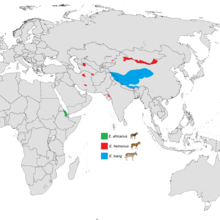Asinus: Difference between revisions
Appearance
Content deleted Content added
Citation bot (talk | contribs) Alter: title. | Use this bot. Report bugs. | Suggested by AManWithNoPlan | #UCB_CommandLine |
taxobox cleanup |
||
| Line 5: | Line 5: | ||
| image = Equus hemionus kulan.JPG |
| image = Equus hemionus kulan.JPG |
||
| image_caption = [[Turkmenian kulan]] (''Equus hemionus kulan'') |
| image_caption = [[Turkmenian kulan]] (''Equus hemionus kulan'') |
||
| taxon = Asinus |
| taxon = Equus (Asinus) |
||
| authority = [[John Edward Gray|Gray]], 1824 |
| authority = [[John Edward Gray|Gray]], 1824 |
||
| type_species = ''[[Equus hemionus]]'' |
| type_species = ''[[Equus hemionus]]'' |
||
Revision as of 00:52, 5 October 2022
| Asinus | |
|---|---|

| |
| Turkmenian kulan (Equus hemionus kulan) | |
| Scientific classification | |
| Domain: | Eukaryota |
| Kingdom: | Animalia |
| Phylum: | Chordata |
| Class: | Mammalia |
| Order: | Perissodactyla |
| Family: | Equidae |
| Genus: | Equus |
| Subgenus: | Asinus Gray, 1824 |
| Type species | |
| Equus hemionus | |
| Species | |

| |
| Range of the three living wild ass species | |
Asinus is a subgenus of Equus (single-toed (hooved) grazing animal) that encompasses several subspecies of the Equidae commonly known as wild asses, characterized by long ears, a lean, straight-backed build, lack of a true withers, a coarse mane and tail, and a reputation for considerable toughness and endurance.
The common donkey is the best-known domesticated representative of the subgenus, with both domesticated and feral varieties. Among the wild ass species, several never-domesticated species live in Asia and Africa.
Taxonomy
- Genus: Equus
- Subgenus: Asinus
- African wild ass, Equus africanus[1][2]
- Nubian wild ass, Equus africanus africanus
- Somali wild ass, Equus africanus somaliensis
- Atlas wild ass, †Equus africanus atlanticus (extinct)
- Donkey, Equus africanus asinus
- Onager or Asiatic wild ass, Equus hemionus
- Mongolian wild ass or khulan, Equus hemionus hemionus
- Indian wild ass or khur, Equus hemionus khur
- Turkmenian kulan, Equus hemionus kulan[3]
- Persian onager or gur, Equus hemionus onager
- Syrian wild ass or achdari, †Equus hemionus hemippus (extinct)
- European wild ass or hydruntine, †Equus hemionus hydruntinus[4] (extinct)
- Kiang or Tibetan wild ass, Equus kiang
- Western kiang, Equus kiang kiang
- Eastern kiang, Equus kiang holdereri
- Southern kiang, Equus kiang polyodon
- Northern kiang, Equus kiang chu
- African wild ass, Equus africanus[1][2]
- Subgenus: Asinus
References
- ^ Don E. Wilson & DeeAnn M. Reeder, ed. (2005). "Equus asinus". Mammal Species of the World. A Taxonomic and Geographic Reference (3rd ed.). Johns Hopkins University Press.
- ^ International Commission on Zoological Nomenclature (2003). "Usage of 17 specific names based on wild species which are pre-dated by or contemporary with those based on domestic animals (Lepidoptera, Osteichthyes, Mammalia): conserved. Opinion 2027 (Case 3010)" (Summary). Bull. Zool. Nomencl. 60 (1): 81–kksiss84.
- ^ "Factsheet: Kulan | Common names: Turkmen Kulan, Turkmenian Wild Ass (Horses and Asses (Perissodactyla Equidae) > Equus hemionus > Equus hemionus kulan)". Archived from the original on 2012-02-08. Retrieved 2011-12-10.
- ^ Bennett, E. Andrew; Champlot, Sophie; Peters, Joris; Arbuckle, Benjamin S.; Guimaraes, Silvia; Pruvost, Mélanie; Bar-David, Shirli; Davis, Simon J. M.; Gautier, Mathieu; Kaczensky, Petra; Kuehn, Ralph (2017-04-19). "Taming the late Quaternary phylogeography of the Eurasiatic wild ass through ancient and modern DNA". PLOS ONE. 12 (4): e0174216. Bibcode:2017PLoSO..1274216B. doi:10.1371/journal.pone.0174216. ISSN 1932-6203. PMC 5396879. PMID 28422966.
External links
- . New International Encyclopedia. 1905.
